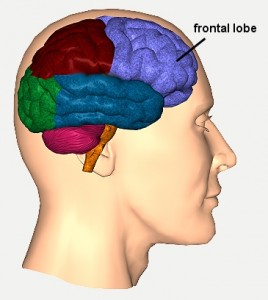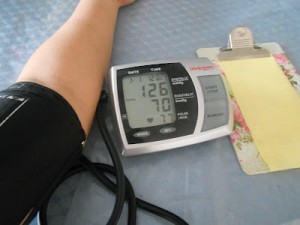This article deals with healthy choices start in your brain. You may have seen the CNN heading “Where is self-control in the brain?” If we want to make any healthy choices in life including sound financial choices, we need a balanced brain that makes the right decisions for us.
Two ways of making food choices
Researchers at the Caltech in Pasadena, CA have examined this question in detail using functional MRI scans and found out that there are two loci on the frontal lobe of the brain that control your impulses: the “ventral medial prefrontal cortex” (red in this link) that processes your initial image (like seeing a delicious ice cream cone”) and the “dorsolateral prefrontal cortex”(green in this link), where you decide that this is not healthy for you because it has too much sugar in it.
Two groups of volunteers
The Caltech researchers found a group of volunteers who were impulsive and made the wrong choice simply based on their taste buds without consideration for their health in general. An equally large group of volunteers was also found who had functional activity in the ventral medial prefrontal cortex and the dorsolateral prefrontal cortex, the latter of which modified the final decision into the healthy choice. The impulsive group made their decision to buy simply with the activation of only the ventral medial prefrontal cortex.
Balanced thinking required to make the right choices
The researchers think that it is this kind of lack of balanced thinking that decides whether we are going to make the right or wrong health choices for ourselves. The sad part is that ultimately, the summation of bad health decisions during life can become the cause of developing dementia, such as Alzheimer’s disease. The good news is that many of the causes of dementia can be avoided, which means that the average person could prevent dementia. I will discuss this in detail here.
Causes of dementia
It is interesting to study patients with various forms of dementia as it is often in the frontal and temporal portions of the brain where brain cells are dying off resulting in impulsive buying, impulsive behavior and lack of recent memory. It is also important to recognize that a number of conditions or factors can cause dementia:
1. Genetic causes
There are two types of frontotemporal lobe dementias, a tau-protein positive FTD and a ubiquitin-positive FTD, which has been shown to be due to a deficiency in progranulin. Both of these genetic defects are located on chromosome 17. In Alzheimer’s dementia, which occurs later in life there can be genetic defects at chromosomes 21, 14 or 19. Epigenetic factors like exercise, avoidance of alcohol, and taking omega-3 supplements can even partially prevent or postpone the onset of dementia from genetic causes.
2. Toxins like alcohol
Another example of how people can get dementia is through the effect that regular alcohol consumption has on our brains and bodies. This image of an MRI scan shows a normal brain for comparison on the right and the MRI scans of the brain of a chronic alcoholic on the left. When a chronic alcoholic has severe atrophy of the brain a psychiatric condition, called Korsakoff’s syndrome can occur. This psychotic condition as a result of the brain having been poisoned by regular alcohol intoxication. Essentially the toxic effect of high daily doses of alcohol have shrunk not only the surface of the brain, but also the deeper substance of the brain. The patient is psychotic, has loss of memory and is unable to care for him/herself.
3. Vascular damage to the brain
Strokes can cause vascular dementia that leads to Alzheimer’s disease-like memory loss. This link points out that diseases like hypertension, obesity, diabetes, atrial fibrillation, ischemic heart disease and dyslipidemia all predispose you to possibly get a stroke with subsequent dementia.
4. Traumatic head injuries
In boxers, football players and combat soldiers brain cells can get lost from repetitive head trauma leading to dementia (in this case it is called “dementia pugilistica”).
5. Infectious dementia
HIV in AIDS patients can affect the brain and cause an HIV-associated dementia. Bacterial meningitis and viral meningitis can kill brain cells and cause a form of dementia as well.
6. Immune disorders
We know that MS can go on to develop dementia as a late complication. In MS there are autoantibodies against myelin, the insulation material that surrounds nerve fibers. An important category of immune disorders is autoimmune disease that can cause dementia. The cardiologist, Dr. William Davis, has presented compelling evidence that wheat allergies can cause dementia, but if detected early and treated by a gluten free diet, this clears up the mind and stops further development of dementia (Ref.1 describes wheat allergies causing dementia; a wheat free diet is described in Ref.2).
7. Hormone deficiencies
A classical example is hypothyroidism, which in the past before thyroid medicine was available, often led to dementia. A simple blood test, TSH (thyroid stimulating hormone) can detect whether or not you are hypothyroid. The A4M recommendation for a normal level is below 2 (not below 5 as often reported by official lab value reports).
8. Lack of vitamins
Thiamine (=vitamin B-1) is often missing in alcoholics. If you are missing vitamin B-6 and vitamin B-12 in your diet, this can predispose you to develop dementia as well. Aging people lose a factor from the gastric mucosa (the intrinsic factor) that is essential to absorb vitamin B-12 in the mall bowel, which predisposes them to develop pernicious anemia and dementia. A simple vitamin B-12 injection can prevent this from happening.
9. Too much sugar consumption
Sugar consumption has skyrocketed in the 1900’s and keeps on going up in the new millennium as well. Here is a review that discusses the possibility that Alzheimer’s can be triggered by overconsumption of sugar. The higher the blood sugar levels in diabetics, the higher the risk for developing Alzheimer’s disease. A study in Seattle has confirmed this. High insulin levels are found in type 2 diabetes; they are responsible for making brain cells stimulate the production of the gooey substance amyloid that causes Alzheimer’s disease. The authors of this study showed this to be true both in humans and in animal models.
10. Lifestyle issues
These include lack of exercise, excessive weight (obesity, being overweight) and poor diet (fast foods). They play an enormous role in terms of causation of dementia in addition to the other factors mentioned. On the other hand organic foods Lack of toxins) and a Mediterranean type diet will preserve your brain cells.
Treatment of dementia
At present treatment of dementia is very limited, as we do not have a complete understanding of dementia at this point. The traditional treatment of dementia outlined here will only marginally delay further deterioration of dementia, but ultimately fail. In my opinion this is because the medical profession has been concentrating on fighting the symptoms of dementia rather than the cause.
Given the known causes mentioned above, I like to give you a list of 6 recommendations. These will help you to prevent Alzheimer’s disease and dementia in general.
Cut out sugar
I would suggest that you cut sugar out of your diet and replace it with stevia. This also includes dates, grapes, bananas; also wheat and wheat products and starchy foods like pasta, potatoes, rice and bread (see Ref. 1 and 2 for details). The manufacturers of soda drinks, pies and cakes will not be happy about this recommendation, but it will please your brain cells. You will also be surprised how easy it is now to lose weight, which will please you (this also lowers your risk for heart attacks and strokes).
Limit your alcohol consumption
Severely limit your alcohol consumption to less than 1 drink for women and 2 drinks for men per day (better still would be to stay sober) unless you want to become part of the hospital population mentioned in one of the links at the beginning of this blog.
Have your hormones checked
Have your hormones checked, particularly your thyroid hormones, but also estrogen and progesterone levels in women and testosterone in men. Our brain cells have hormone receptors for a reason. They need stimulation from our hormones, even in menopause or andropause. Replace the missing sex hormones with bioidentical hormone creams and missing thyroid hormones with thyroid tablets (Armour is the best mix of T3 and T4 thyroid hormones, not Synthroid).
Prevent repetitive brain injuries
Prevent repetitive brain injuries before it is too late. Rethink whether you really need to box, street fight, play football, rugby or hockey. An Accumulation of head concussions can cause Alzheimer’s later in life!
Use vitamins for prevention of dementia
Use vitamins for prevention of dementia: The B complex vitamins like B-2, B-6, B-12 (by injection); vitamin D3 has recently been shown to be effective in slowing down Alzheimer’s disease. Vitamin D3 is low in Alzheimer’s patients and vitamin D3 supplements will slow down this disease. Although vitamin C showed equivocal results, it does have some neuroprotective qualities and decreases β-amyloid production and acetyl cholinesterase activity. A Mediterranean-type diet (Ref.2) is also helpful in preventing dementia
Do regular exercise
Exercise daily. It will discipline you to stick to the other points mentioned above. It gives you some extra endorphins and will make you feel good about yourself.
Conclusion
Although we do not yet have a complete picture regarding Alzheimer’s disease and dementias, we do know enough to reduce our risk of getting them. When you cut out wheat and wheat products, your immune system stops production of autoimmune antibodies against your brain cells. Your opiate receptors in the brain will no longer seduce you to eat more and more sugar, starchy foods or high fructose corn syrup. You no longer have a problem cutting out high glycemic index foods (Ref.1). This will reduce insulin and reduce IGF-1 growth factors. These can lead to the production of the gooey amyloid substance that makes you lose your memory. The orbitofrontal part of your brain (particularly the dorsolateral prefrontal cortex) will be reminding you what you read here: healthy lifestyle choices start in your brain.
References
1. William Davis, MD: “Wheat Belly. Lose the Wheat, Lose the Weight, and Find Your Path Back to Health”. HarperCollins Publishers LTD., Toronto, Canada, 2011.
2. William Davis, MD: “Wheat Belly Cookbook. 150 Recipes to Help You Lose the Wheat, Lose the Weight, and Find Your Path Back to Health”. HarperCollins Publishers LTD., Toronto, Canada, 2012.
Last edited Oct. 19, 2013















